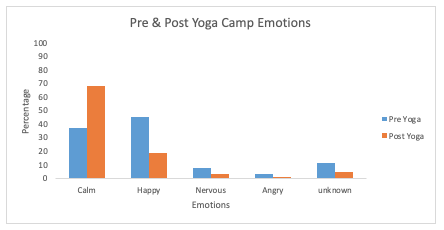Learn how the principles of Acceptance and Commitment Therapy with yoga is helping children feel calm during the pandemic.
During summer camp, children’s yoga intervention was implemented using the principles of Acceptance and Commitment Therapy (ACT). The hypothesis was when children participated in mindfulness and relaxation activities such as yoga, children’s emotions would regulate into a calmer and more relaxed state. Camp participants ranged from kindergarten to grade eight.
Before yoga camp, each participant completed a pre-yoga survey to identify their emotions. The survey had four emotions presented through emojis. The emojis shown were calm, happy, nervous and angry. The instructor explained each emotion while providing one to two examples. For example, the instructor explained to participants being nervous sometimes is noticed by breathing heavier or shaking hands, as if you were participating in a new activity in front of an audience. An example of being angry was referenced when playing with a toy and another peer takes the item without permission.
The participants were instructed to circle one emoji they were feeling in the present moment. After the camp was over, the participants were asked to complete the post-yoga survey and circle one emoji representing what they were feeling in the present moment.
It was hypothesized younger children in kindergarten and first grade would benefit from extra time reviewing and receiving more training on understanding their feelings, due to observations of them asking for more assistance to explain emotions. It was observed when training was provided in the form of acoustic instruction, the younger children could tact their feelings with more fluency.
The graph below shows the younger children often circled two emojis after being instructed to only circle one. Having the children only circle one limited the research, and future research highly suggested to include the possibility of circling more than one. When participants circled two emojis, it recorded data as unknown. Throughout the intervention, the unknown category stayed consistent with each age group, and neither increased nor decreased in trends. Through yoga lessons, the younger children demonstrated behaviors such as smiling, engaging in the yoga story through appropriate commenting, and laughing.
Participants in second grade through fourth grade completed the surveys promptly within two minutes by quickly circling one emoji and preparing for the lesson. It was observed the participants continued to smile and appropriately commented during the yoga stories with peers and instructor.
Participants in fifth grade through eighth grade also benefited from more peer-related yoga activities and challenges due to observing their conversations, and sitting next to the same peer group each week — however, it was essential for participants to complete poses individually to practice physical distancing. This age group demonstrated interest in participating in yoga poses and relaxation through peer conversations and positive facial expressions that included smiling.
Due to the increase of camp participants throughout the four weeks, and the instructor training new participants for survey participation, the camp dynamic and individual experience may have been affected. Camp numbers varied throughout, and some participants only received one yoga session. In contrast, other participants participated in four yoga sessions. This could affect intervention efficacy. For future interventions, it would be best to document the number of yoga sessions each participant completed, and analyze survey results of only those participants who participated in a minimum of four yoga sessions.
The graph shows participants reported emotions pre and post-yoga class, demonstrating a considerable increase in participants experiencing calm emotions after participating in yoga lessons by 31%. The graph shows participants before the yoga lesson experiencing emotions of being nervous and angry. There was a shift in a participant’s experience from happier emotions before yoga to feelings of relaxation after. It was observed through the self-report surveys that teaching yoga to children increases covert behaviors of relaxation and calm, therefore, is an option to helping children feel calm.











